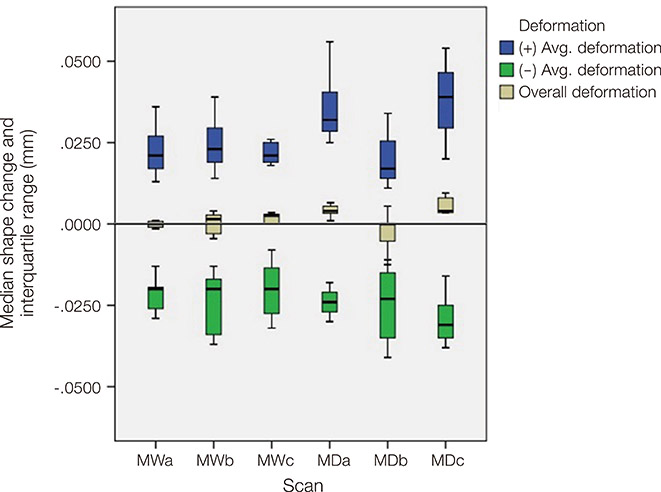J Adv Prosthodont.
2016 Aug;8(4):296-303. 10.4047/jap.2016.8.4.296.
Three dimensional deformation of dry-stored complete denture base at room temperature
- Affiliations
-
- 1Department of Prosthodontics, College of Dentistry, Dankook University, Cheonan, Republic of Korea. joon322@dankook.ac.kr
- KMID: 2349338
- DOI: http://doi.org/10.4047/jap.2016.8.4.296
Abstract
- PURPOSE
The aim of this study was to evaluate whether there is any typical deformation pattern existing in complete denture when it was dried by using the 3D scanner and surface matching program.
MATERIALS AND METHODS
A total of 28 denture bases were fabricated with heat curing acrylic resin (each 14 upper and lower denture bases), and 14 denture bases (each 7 upper and lower denture bases) were stored in the water bottle (water stored), and another 14 denture bases were stored in the air (dry stored). Each specimen was scanned at 1st day after deflasking, 14th day after deflasking, and 28th day after deflasking, and digitalized. Three dimensional deformation patterns were acquired by comparison of the data within storage group using surface matching program. For evaluating differences between groups, these data were compared statisticallyusing Kruskal Wallis and Mann Whitney-U test (α=.05).
RESULTS
When evaluating 3D deformation of denture base, obvious deformations were not found in maxillary and mandibular water storage group. However, in dry stored group, typical deformation pattern was detected as storage time passes. It occurred mostly in first two weeks. Major deformations were found in the bilateral posterior area in both maxillary and mandibular group. In maxillary dry stored group, a statistical significance was found.
CONCLUSION
It was proved that in both upper and lower denture bases, dry storage caused more dimensional deformation than water storage with typical pattern.
Keyword
Figure
Reference
-
1. Winkler S. Denture base resins. Dent Clin North Am. 1984; 28:287–297.2. Peyton FA. History of resins in dentistry. Dent Clin North Am. 1975; 19:211–222.3. Skinner EW, Cooper EN. Physical properties of denture resins: part I. Curing shrinkage and water sorption. J Am Dent Assoc. 1943; 30:1845–1852.4. Taylor PB. Acrylic resins: Their manipulation. J Am Dent Assoc. 1941; 28:373–387.5. de Gee AJ, ten Harkel EC, Davidson CL. Measuring procedure for the determination of the three-dimensional shape of dentures. J Prosthet Dent. 1979; 42:149–153.6. Wong DM, Cheng LY, Chow TW, Clark RK. Effect of processing method on the dimensional accuracy and water sorption of acrylic resin dentures. J Prosthet Dent. 1999; 81:300–304.7. Sweeney WT, Paffenbarger GC, Beall JR. Acrylic resins for dentures. J Am Dent Assoc. 1942; 29:7–33.8. Woelfel JB, Paffenbarger GC, Sweeney WT. Changes in dentures during storage in water and in service. J Am Dent Assoc. 1961; 62:643–657.9. Peyton FA, Mann WR. Acrylic and acrylic-styrene resins: Their procedures in relation to their uses as restorative materials. J Am Dent Assoc. 1942; 29:1852–1864.10. Yeung KC, Chow TW, Clark RK. Temperature and dimensional changes in the two-stage processing technique for complete dentures. J Dent. 1995; 23:245–253.11. Darvell BW, Clark RK. The physical mechanisms of complete denture retention. Br Dent J. 2000; 189:248–252.12. Mowery WE, Burns CL, Dickson G, Sweeney WT. Dimensional stability of denture base resins. J Am Dent Assoc. 1958; 57:345–353.13. Consani RL, Monteiro VL, Mesquita MF, Consani S. The influence of storage on dimensional changes in maxillary acrylic denture bases and the effect on tooth displacement. Eur J Prosthodont Restor Dent. 2011; 19:105–110.14. Zarb GA, Bolender CL, Carlsson GE. Boucher's prosthodontic treatment for edentulous patients. 11th ed. St. Louis: CV Mosby;1997. p. 380.15. Lee SH, Chang IT, Yim SH. Dimensional accuracy of denture base using laser scanner of reverse engineering technic. J Korean Acad Prosthodont. 1999; 37:167–184.16. Kim MJ, Kim CW. A comparative study on the dimensional change of the different denture bases. J Korean Acad Prosthodont. 2006; 44:712–721.17. Artopoulos A, Juszczyk AS, Rodriguez JM, Clark RK, Radford DR. Three-dimensional processing deformation of three denture base materials. J Prosthet Dent. 2013; 110:481–487.18. Kimoto S, Kobayashi N, Kobayashi K, Kawara M. Effect of bench cooling on the dimensional accuracy of heat-cured acrylic denture base material. J Dent. 2005; 33:57–63.19. Consani RL, Mesquita MF, Consani S, Correr Sobrinho L, Sousa-Neto MD. Effect of water storage on tooth displacement in maxillary complete dentures. Braz Dent J. 2006; 17:53–57.20. Frejlich S, Dirckx JJ, Goodacre CJ, Swartz ML, Andres CJ. Moire topography for measuring the dimensional accuracy of resin complete denture bases. Int J Prosthodont. 1989; 2:272–279.21. Ristic B, Carr L. Water sorption by denture acrylic resin and consequent changes in vertical dimension. J Prosthet Dent. 1987; 58:689–693.
- Full Text Links
- Actions
-
Cited
- CITED
-
- Close
- Share
- Similar articles
-
- Comparative study of volumetric change in water-stored and dry-stored complete denture base
- Fabrication of computer-aided design/computer-aided manufacturing complete denture and conventional complete denture: case report
- DIMENSIONAL ACCURACY OF DENTURE BASE USING LASER SCANNER OF REVERSE ENGINEERING TECHNIC
- Complete denture artificial teeth arrangement deformation in wax denture after festooning: deformation over time
- A STUDY ON DIFFERENT AMOUNT OF DENTURE BASE DISPLACEMENT USING SOFT DENTURE RELINING MATERIAL UNDER MASTICATORY FORCE







